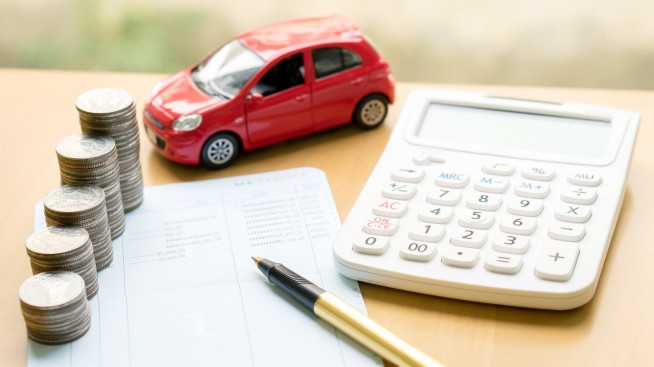What is a good interest rate & APR for a car loan?

When it comes to purchasing a vehicle, there’s a lot to consider, such as what make and model you’d like, what gas mileage you need, and so on. But figuring out how to finance your next vehicle purchase is one of the most important steps in the process. When you’re comparing car loan options, you’ll see two terms — interest rate and APR. These both give you an idea of how much it costs to take out a car loan. We’ll show you the difference between APR and interest rate and share some tips to help you get better rates next time you buy a vehicle.
Understanding APR and interest rate
While a loan’s interest rate and APR may look similar, there are some key differences you should understand before you finance a car. An interest rate is the percentage banks charge you for borrowing money. When you make monthly payments on a car loan, your payment will go toward both your principal balance and your interest charges.
When you finance a car, the annual percentage rate, or APR, is the total cost of interest, fees, and prepaid expenses expressed as an annual rate over the life of the loan. Because it includes the cost of certain prepaid charges you’ll pay, APR can give you a much better picture of how much you’re actually paying for a car loan.
What determines your interest rate on a car loan?
Interest rates are not the same for every person and are determined based on several factors. Here are some of the things that may affect your interest rate when financing your vehicle:
Credit score
Typically, the higher your credit score, the lower your interest rate will be. That’s because a high credit score indicates that you have a good history of paying off your debts on time, so you’re a less risky borrower. If you’d like to check your credit score, you can use Chase Credit Journey® to find your score for free without hurting your credit.
The vehicle
The vehicle you purchase may also affect your interest rate. New vehicles tend to have a lower interest rate, sometimes even as low as 0%, while used vehicles usually have a higher interest rate.
Loan term
Longer loan terms tend to have higher interest rates than short-term loans. So, while you will have to pay a higher amount each month on the principal, with a short-term loan (think 24 months), you may save a lot of money on interest.
Lender
Interest rates vary. You should compare interest rates from several lenders to see which ones offer the best prices. You can also finance your vehicle through the vehicle manufacturer whose rates may be different.
What determines your APR on a car loan?
APR accounts for both your car loan interest rate and the cost of any financing fees and prepaid expenses. The Truth In Lending Act (TILA), a federal law, requires lenders to disclose the APR on your vehicle purchase before signing a loan agreement. An example of a prepaid expense would be an origination fee.
Interest rate
Your interest rate usually makes up the biggest part of the total APR on your vehicle. Because of this, lowering your interest rate can help you get the best APR on your car loan.
Origination fees
A loan origination fee is the amount of money you’ll pay upfront to cover the cost of processing your loan. These fees can be a small percentage of your loan amount or a flat fee.
What is a good interest rate on a car?
The best interest rate on a car loan is the lowest one you can get, but watch out for fees that will drive up your cost. With a lower interest rate, you’ll save on the total cost of the car loan and pay lower monthly payments.
How to get the best car loan interest rate
Something you can do to lower your interest rate is raise your credit score. While it takes time to improve your credit score, there are several steps you can take, like paying your bills on time or keeping the balance on your credit cards low.
Asking for a shorter loan term is another way to lower your interest rate since you’ll be borrowing from a lender for a shorter period of time. While this isn’t a realistic option for everyone, if you’re able to afford the higher monthly payments from short-term loans, it’s a solid way to decrease your overall financing costs.
If you have a poor or no credit history, getting a cosigner for your loan agreement might be a viable option for lowering your interest rate. Having a reliable, willing friend or family member sign on to take responsibility for the loan in case you default on it might make lenders feel as though you’re less of a risk, and therefore offer lower interest. Be cautious when doing this though, since your relationship with the cosigner could be harmed if you fail to pay off your loan and they’re left with the bill.
What is a good APR for a car loan?
A good APR is, like interest rates, one that is as low as possible. They can vary widely depending on several factors, but there are some things you can do to lower your APR on a car loan.
How to lower your APR on a car loan
Since interest rates make up a big portion of your total APR, everything mentioned above to help lower interest rates can help lower your APR. But there are other things to consider as well, like negotiating any prepaid fees the lender might charge. Shopping around for the best APR deal is another great way to find a lower APR. Some dealerships may offer special deals on newer vehicles such as 0 percent APR to incentivize buyers.
When shopping for a vehicle, keep your mind open to the ways in which you can save on both interest rates and APR — you may have more control over what you’ll pay than you think.
To learn more about interest rates and APRs, go to the Chase Auto site.



